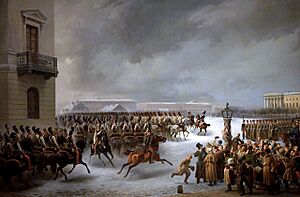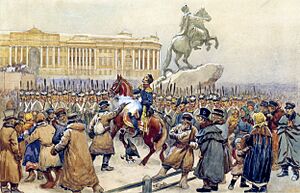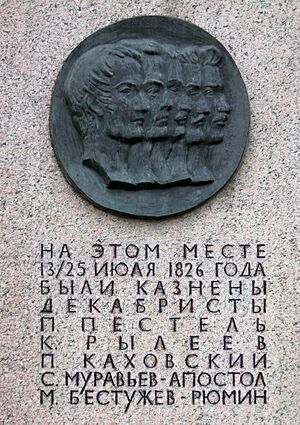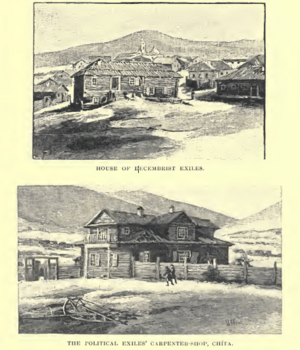Decembrist revolt facts for kids
Quick facts for kids Decembrist Revolt |
|||||||
|---|---|---|---|---|---|---|---|
| Part of the Revolutions during the 1820s | |||||||
 Decembrists at Peter's Square (Georg Wilhelm Timm, 1853) |
|||||||
|
|||||||
| Belligerents | |||||||
| Northern Society of Decembrists | |||||||
| Commanders and leaders | |||||||
| Sergei Trubetskoy Yevgeny Obolensky Nikita Muravyov Pavel Pestel Pyotr Kakhovsky Kondraty Ryleyev |
|||||||
| Strength | |||||||
| 3,000 soldiers | 9,000 soldiers | ||||||
The Decembrist Revolt was a major event in Russian history. It was a failed attempt by a group of military officers and nobles to change how Russia was ruled. These officers, called Decembrists, wanted to make Russia more modern. They hoped to replace the old system, where the emperor had all the power, with a new one. This new system would either be a constitutional monarchy (like in Britain) or a republic (like the United States).
The revolt happened in Saint Petersburg on December 26, 1825. This was right after Emperor Alexander I died suddenly. His younger brother, Nicholas, was supposed to become the new emperor. But there was some confusion about who should rule. The Decembrists tried to use this confusion to start their uprising.
Contents
Why the Decembrists Wanted Change
Many officers had fought in the Napoleonic Wars across Europe. They saw how other countries lived and how their governments worked. They also saw the hard lives of Russian peasant soldiers. This made them want big changes in Russia.
Early Ideas for Reform
At first, Tsar Alexander I seemed open to new ideas. He even encouraged some liberal changes. People like Mikhail Speransky worked on plans to improve Russia's government. There was also talk about ending serfdom, which was a system where peasants were tied to the land.
However, the tsar later became more conservative. He stopped many of the reforms. This disappointed the officers who wanted change.
Secret Societies Form
Because open reform was difficult, some officers formed secret groups. These groups wanted to bring about change themselves.
- The Union of Salvation was one of the first groups, started in 1816. Its members wanted to end serfdom and create a constitution.
- Later, the Union of Prosperity was formed. It was a bit less radical at first.
These groups discussed different ways to change Russia. Some wanted a constitutional monarchy, where the emperor's power would be limited by laws. Others wanted a republic, with no emperor at all. They also disagreed on how to free the serfs. Some wanted the serfs to get land, while others thought the landlords should keep it.
After a small army mutiny in 1820, these secret societies became even more secretive. They split into two main groups:
- The Southern Society, led by Pavel Pestel, was based in Ukraine. They were more radical and wanted a republic. They also wanted to give half the land to the state and divide the rest among peasants.
- The Northern Society, based in Saint Petersburg, was led by officers like Nikita Muravyov and Sergei Petrovich Trubetskoy. They preferred a British-style constitutional monarchy. They also supported ending serfdom, but with landlords keeping their land.
The Uprising in Senate Square
When Emperor Alexander I died in December 1825, there was a lot of confusion. His brother, Konstantin, was next in line. But Konstantin had secretly given up his claim to the throne years earlier. This meant their younger brother, Nicholas, would become emperor.
A Plan for Change
The Decembrists saw this moment of confusion as their chance. They tried to convince army units not to swear loyalty to Nicholas. Their plan was to gather soldiers in Senate Square and demand a new government. They chose Sergei Petrovich Trubetskoy to lead their revolt.
The Standoff
On the morning of December 26, about 3,000 rebel soldiers gathered in Senate Square. They refused to swear loyalty to Nicholas I. They hoped more soldiers would join them, but this did not happen. To make things worse, their chosen leader, Prince Trubetskoy, did not show up. Another officer, Yevgeny Obolensky, took over.
For several hours, the 3,000 rebels faced about 9,000 loyal troops. A large crowd of civilians watched, but they did not join the fight. Nicholas I, the new tsar, came to the square himself. He sent General Mikhail Miloradovich to talk to the rebels. Sadly, Miloradovich was shot and stabbed by Pyotr Kakhovsky, one of the Decembrists.
The End of the Revolt
After trying to talk to the rebels for hours, Nicholas ordered his army to fire cannons. The cannons shot grapeshot, which is like many small bullets. This caused a lot of damage and made the rebels scatter. Some tried to regroup on the frozen Neva River, but the cannons broke the ice, and many fell into the cold water. The revolt in Saint Petersburg was over.
Arrests and Punishment
After the revolt, the government quickly arrested many Decembrists.
Southern Society's Fate
The Southern Society in Ukraine also tried to revolt, but their leader, Pavel Pestel, was arrested before they could act. Other members were arrested too. Some members of a group called the United Slavs freed a few arrested leaders, including Sergey Muravyov-Apostol. He led a small rebellion, but they were quickly defeated by loyal troops.
Trials and Sentences
All the captured Decembrists were taken to the Winter Palace for questioning and trial.

Five main leaders were sentenced to death by hanging:
- Pavel Pestel
- The poet Kondraty Ryleyev
- Pyotr Kakhovsky (who shot Miloradovich)
- Sergey Muravyov-Apostol
- Mikhail Bestuzhev-Ryumin
Many other Decembrists were sent to prison or exiled to Siberia, a very cold and distant part of Russia. Even famous writers like Alexander Pushkin were suspected of being involved.
Decembrists in Siberia
Life in Siberia was very hard for the exiled Decembrists. They faced long journeys, harsh conditions, and strict rules.
Life in Exile
The first group of Decembrists arrived in Siberia in July 1826. Many were sent to work in mines or live in isolated settlements. These places were far from cities and often had few other Russians. The local people, like the Evenks and Yakuts, were often very kind to the exiles. They respected the Decembrists for standing up for their beliefs.
Most prisoners were sent to Chita, Zabaykalsky Krai, and later to Petrovsky Zavod. The government wanted to keep them together to watch them closely. But this also allowed the Decembrists to form a community. They taught each other languages, arts, and music. They even set up schools and libraries.
Wives of Decembrists
Many wives of the Decembrists chose to follow their husbands into exile. These women, known as Dekabristki, gave up their comfortable lives to be with their husbands. They became symbols of loyalty and devotion. They worked hard, sending many requests to the emperor to improve their husbands' conditions. Thanks to their efforts, some Decembrists were allowed to live with their wives and had their hard labor duties reduced.
Impact on Siberia
Even in exile, the Decembrists made a big difference in Siberia. They introduced new crops and farming methods. Doctors among them helped organize medical care. Their homes became social centers, and they encouraged education for everyone. They helped bring new ideas and knowledge to the region.
Amnesty and Return
In 1856, when Alexander II became emperor, he granted amnesty to the Decembrists. This meant they were forgiven and could return home. Their rights and titles were restored. However, not all of them returned. Some were too old or sick, and others had made Siberia their new home. Those who did return were eager to see reforms happen, especially the end of serfdom.
What Happened After the Revolt?
The Decembrist Revolt failed, and Russia remained an autocracy for many more years. However, the revolt was not forgotten.
Changes in Russia
Even though the Decembrists lost, their actions made Nicholas I pay more attention to problems in Russia. He appointed some former Decembrist sympathizers to his government. In 1826, he asked Mikhail Speransky to organize all Russian laws into a clear system. This was a big step in modernizing Russian law.
Legacy of the Decembrists
The Decembrists became heroes to many people who wanted change in Russia. Writers like Alexander Pushkin and Leo Tolstoy wrote about them. Their story inspired later movements for reform. The Decembrist Revolt is seen as the start of a revolutionary movement in Russia. It showed the growing gap between the government and those who wanted a more modern and fair society.
See also
- Union of Salvation (film)




